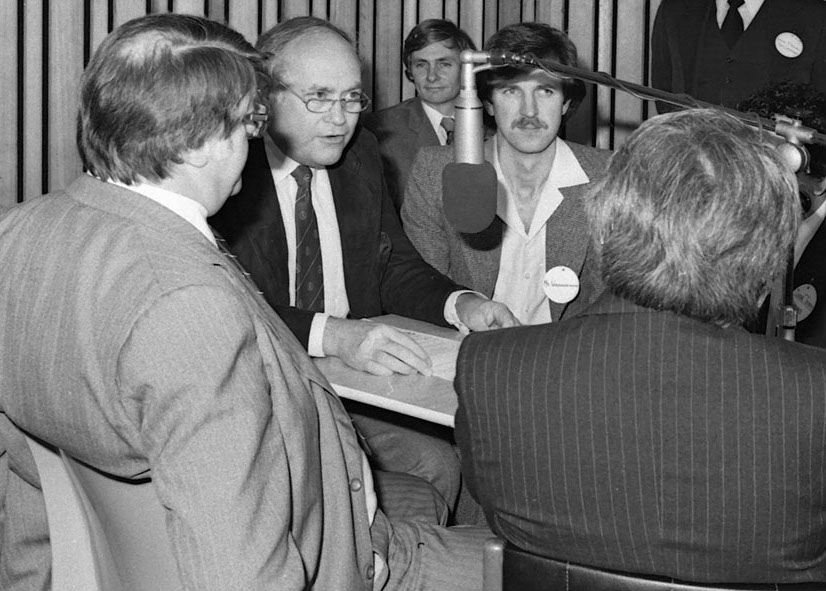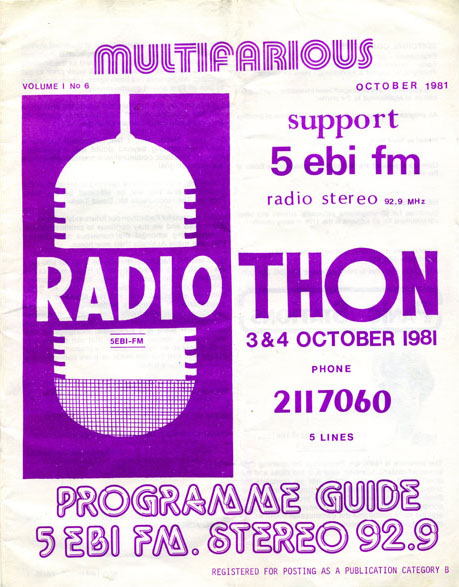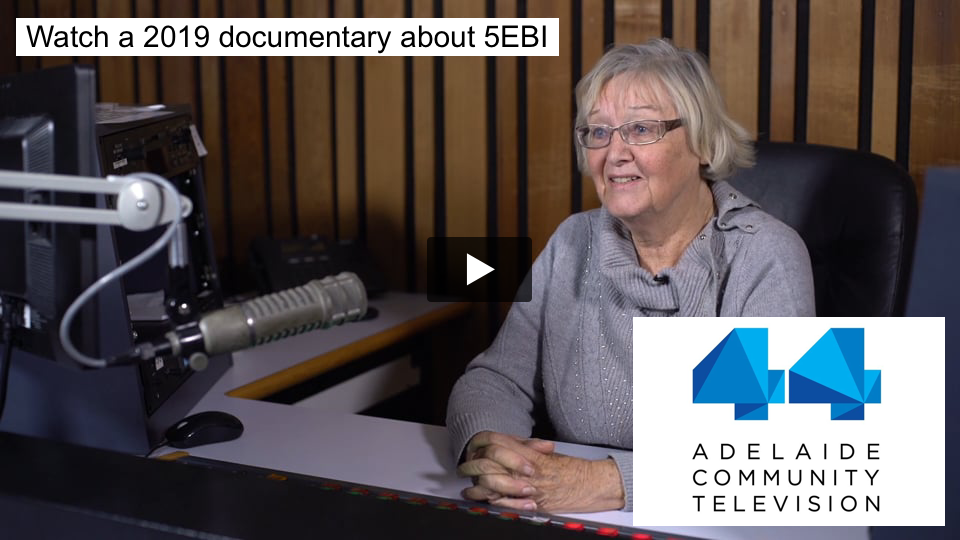History
5EBI is not only the largest and only full time multicultural broadcaster in South Australia. It is also Australia’s very first and longest running ethnic radio station, with a history that began more than 45 years ago.
Read on for more details…

1970s History
1974
Ethnic broadcasting in South Australia started as an experiment at Adelaide University’s radio 5UV. Paul Kokke, 5EBI Life Member, said the radio program was originally set up to support migrants in their transition from the old to the new country and helped them to preserve their identity. People felt that radio was an opportunity for maintaining their culture.
The very beginning of ethnic broadcasting in Adelaide came when Paul Kokke produced a Dutch program on the commercial station 5KA. Following this, a letter was written to Keith Conlon, the producer and manager of 5UV, outlining suggestions and plans for a radio program for the Netherlands community and for inclusion of other European language programs. At the same time the University of Adelaide’s department for Adult Education prepared a seminar on community broadcasting. Different ethnic groups had the opportunity to discuss the potential of ethnic broadcasting.
1975
Ethnic Broadcasters was established at the beginning of 1975, with five ethnic groups included: Italian, Dutch, Polish, Ukrainian and Greek.
On Monday the 3rd of March 1975, the very first broadcast of the Italian programme (then called Radio Paesani) marked the start of ethnic broadcast. It was followed by the Dutch family program on Wednesday 5th March and then the Ukrainian on Saturday 8th March. Shortly afterwards the Polish and Greek started their programs.
1977
By the end of 1977 twenty-six community groups were broadcasting, using the facilities at 5UV.
They took up almost half of 5UV’s broadcasting time. More and more groups wanted to broadcast, but they couldn’t be accommodated on air.
Early in 1977, Ethnic Broadcasters applied for a grant to operate. They were granted $ 45,000 by the Primer of the state, the Hon. Don Dunstan, and a further $ 17,000 by the Western Adelaide Regional Council for Social Development. The money was used for a studio facility and to purchase equipment to furnish a radio station. Premises were found in Cresco House, on North Terrace, Adelaide.
An article in The Advertiser in June 1977 described the station at the time as follows:
“The studio is small with an announcer’s desk, two tape recorders, a couple of chairs, no sound proofing and one wall, not up to the ceiling, next to a busy office.”
It soon became obvious that a new studio would be needed, to accommodate the increasing demand for broadcast times. Before the year was up in Cresco House, Ethnic Broadcasters was on the move – this time to 24 Parker Street, Mile End, with 28 groups involved.
1978
In 1978, Ethnic Broadcasters became incorporated, now known as EBI.
The young radio station was determined to make its dream of independence reality. In June 1978 they applied for a broadcast licence. An FM licence in the ‘S’ category was granted. The category concerned with programs “servicing a particular interest or group of interests”. The first step after obtaining the licence was to negotiate with a television channel for the use of their main mast at Mt. Lofty as a transmitter site. There was also a plan to buy additional studio equipment in the following year.
On the 6th October 1978 5EBI was granted the first ethnic public broadcasting license in Australia on the FM band.The Advertiser of the 4th September 1978 reported that Ethnic Broadcasters Inc. had “the initiative, energy and imagination” to make a bid for the two available FM licences. This reflected the organisation’s increasing confidence. They would be able to meet the demands of the various communities for information and entertainment in languages other than English. EBI had proven to be a responsible community-supported broadcaster. The experience with 5UV had shown capability of managing its own station, which supported their application for a radio licence.
EBI Chair Walter de Veer expressed how 5EBI would continue to progress and improve, owing to the radio committees being community-based. He also asserted they would supplement – instead of competing with – existing radio services. He later recalled how exited and proud everyone was that the licence was granted.
To celebrate the granting of the FM radio licence, the first 5EBI ball was held on November the 10th, which was a huge success with most of the ethnic groups participating.
1979
From 5EBI archives, it is evident that there was very little money and the production studio was described as being the size of a ‘telephone booth’. The state government granted $ 20,000 to EBI to provide a third broadcast studio. From the primitive conditions, the money from the Government was used to furnish a third modern and comfortable studio.


1980s History
1980
On the 6th January 1980 5EBI made its FM debut on 102.3Mhz.
The station’s official launch was on February 2nd, with approximately 200,000 people expected to tune in. At the time the station was controlled by 33 committees, elected by ethnic and language groups in South Australia.
Two months after commencing transmission on 102.3 Mhz, 5EBI were extremely happy with their progress. They had many more live programs, compared to their time at 5UV, where the majority of programs were pre-recorded, and the station was receiving a “fantastic response” from their listeners. In the words of 5EBI’s secretary at that time, George Kokoti, having more live programs created a real station atmosphere and helped to “bring the audience closer to us”. There were letters from people more than 90km away. 5EBI was broadcasting more than 100 hours of programs each week.
The problem was that the station developed faster than expected; expanding at such a rate that its present premises couldn’t cope. New programs were starting constantly, placing more demands on studio time. More studio space was needed, and so plans to move to another building were inevitable.
From September 1980, 5EBI, having lost its battle with the Post and Telecommunications Department over frequency changes, thus being forced to shift to a new frequency on the FM dial, was to be heard on 92.9 Mhz.
The change from Mile End to 10 Byron Place, where the white brick antique salesroom was to be transformed into a modern radio station, was a very big event. On the 1st of October the present building was purchased – EBI borrowed money to equip the place properly. At first it was very difficult to pay accounts, such as electricity, thus forcing EBI to pay them in bits, as well as prioritising their payments. During this time of the planning development, many unofficial meetings and relevant discussions were held at the local Hungry Jack’s. With lots of patience and good management, the building was eventually paid off.
1981
On October the 3d, 1981, 5EBI started broadcasting for the first time from their new $ 110,000 premises at 10 Byron Place, Adelaide, between Grote and Gouger Streets in the city. The call sign changed; the letters FM were added. The station could now broadcast in stereo with increased quality, especially for its music broadcasting. This was a tremendous boost for a radio station just beginning to flourish under its own steam.
The station ‘switched on’ with a two-day Radiothon, to raise funds for the three studio building. The station was off to a good start with a donation from the Government of South Australia. The new station converted from an old warehouse, encompassed reception offices, storage for records, library, meeting rooms, studios, record library, kitchen and bathrooms. The ethnic communities made the move possible through devoted efforts and an unusual degree of co-operation. They could put aside individual politics and all differences, and put in the effort – donating their time and labour. The station had been overwhelmed by the response from listeners to appeals for help in converting and renovating the warehouse. The support of the Adelaide City Council must also be commanded for the way the building application process was handled, to enable an easy and quick conversion to a full scale radio station.
The new premise was opened by the Primer of South Australia, Mr. David Tonkin. The newspaper covering the opening event conveys the atmosphere as ‘truly cosmopolitan …with people wearing the national dress of their countries of origin mingling with the multinational crowd of station workers and media representatives.’
Members of the 5 EBI family were drawn from about 47 language communities, each with a radio committee, consisting of a president, vice president, secretary, treasurer and members. The committee’s many responsibilities include overseeing production, handling conflicts and paying fees to EBI.
Program contents varies greatly and is subject to the presenter. Almost all of 5 EBI’s programs are produced by volunteers. They dedicate their time to help preserve the language, culture and traditions of their home countries. But it’s not all hard work. They also have the opportunity to meet people from other ethnic backgrounds. New volunteers are always welcome at 5EBI. The station and the communities benefit from getting more people involved. The presenters are able to touch the soul of their listeners through their program.

1984
The year 1984 marked a new beginning in Ethnic Broadcasting throughout Australia. The Public Broadcasting Association of Australia was seen as inadequate to promote and further ethnic community broadcasting. 4EB in Brisbane and 5EBI joined forces to help establish the National Ethnic Multicultural Broadcasting Council (NEMBC). Luigi Penna, vice chairman of 5EBi at that time, was one of the first Vice presidents. Hans Degenhart, life member of 5 EBI, was an Executive member and Treasurer for many years. His wife Brenda Degenhart held the Chair of the Woman’s sub-committee for 2 years.
5 EBI has also been involved in festivals and other multicultural events. Their special Outside Broadcast Van (OBV) was purchased and opened in 1985 by Chris Summer, Minister for Ethnic Affairs and Attorney General. Since then it has been used extensively to broadcast from events like the Schützenfest, Adelaide Royal Show, Glendi, Spanish Festival. Many radio groups have used the OBV to promote their events on air and as a public address system at functions.
1990s History
1991
In 1991, 5EBI bought the property at 27 Oakley Street, at the back of 10 Byron Place.
After 4 months of hard work, the new premises provided a great resource to the organisation, including 3 offices and a meeting room. The backyard was paved and could be used as car park or for outdoor functions.
2000s History
2000
In 2000, EBI’s interior and exterior had a face lift. At the same time internet and satellite services were introduced. New studio technology was purchased to keep up with the development of commercial radio stations.
2004-2008
The two majors studios 1 and 2 were given a full redesign by the station’s Senior Technician Andy Wlordarczak, including a brand new, state of the art, broadcasting desk for each.
2009
May 2009 saw the launch of digital radio in Adelaide, which 5EBI was a part of, now extending its reach from the FM band to the digital as EBIWORLD.
2010s History
2010
In August 2010, 5EBI unveiled its new logo, still in use today.
At the same time, 5EBI made its first steps in the world wide web. 5ebi.com.au was launched and online live streaming began. Now the entire planet could connect with 5EBI’s ever evolving South Australian multicultural community and “hear a world of difference”.
2017
In 2017, EBI’s studio equipment was upgraded, at long last introducing computerised recording and broadcasting technologies. 5EBI got their very own ‘Message Player’, custom designed by local community radio volunteer David Corkill, based on his original concept, used by sister community radio station Three D Radio for many years. Over several months, more than a hundred training sessions were held on an almost daily basis, to bring the 250+ 5EBI volunteer broadcasters into the 21st century.
That same year, 5EBI received a $107,000 grant from the South Australian Government, appropriately titled ‘It’s About Time’, to give the station a new coat of paint, new carpet, air conditioning system and a much needed new front signage.
The 2020s
2020
In March 2020, the members of EBI voted to adopt a brand new constitution.
On the 9th June, 5EBI’s new website went live. For the first time, an interractive program grid lets you access 5EBI programmes on demand for up to 8 weeks.

